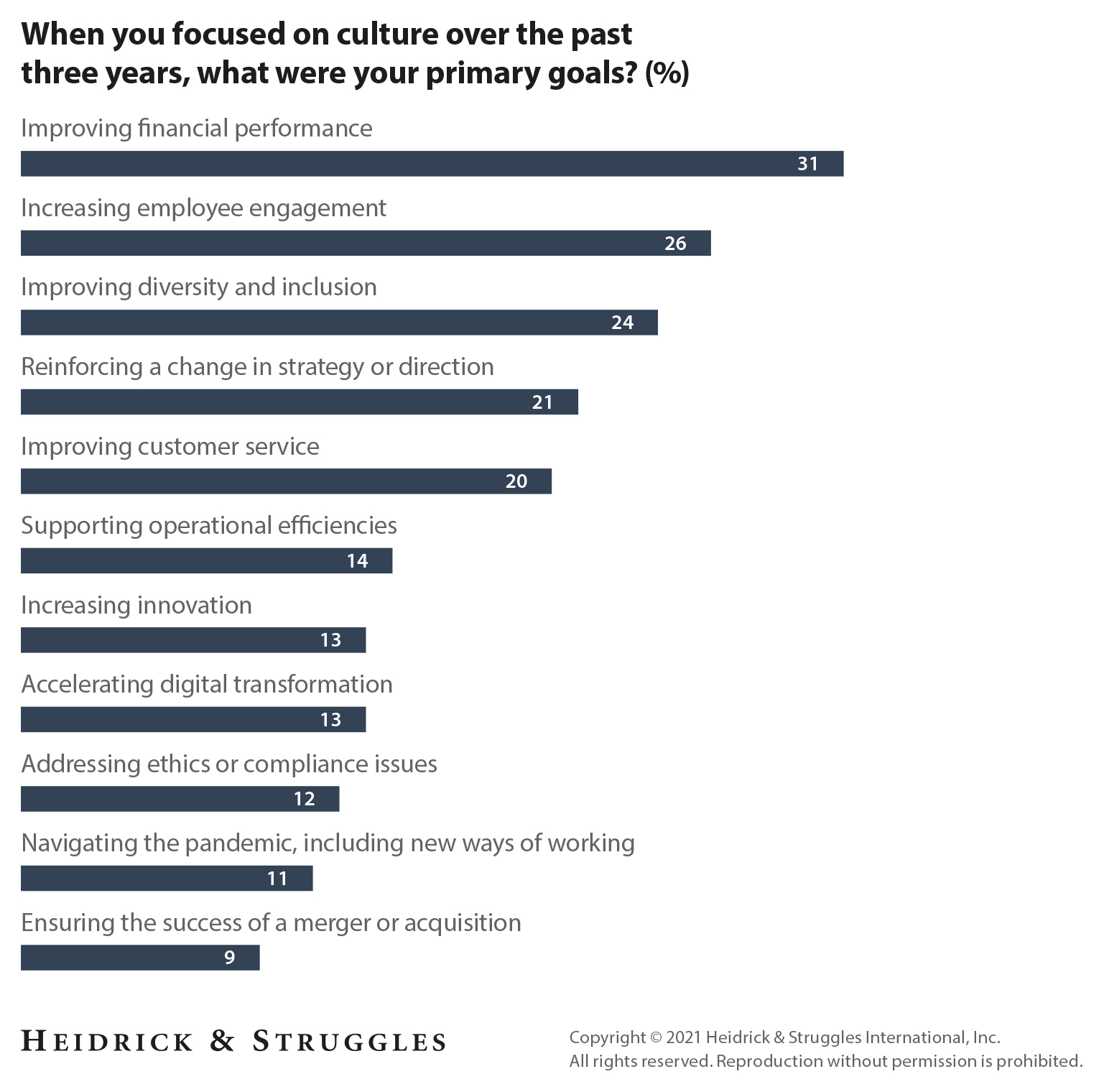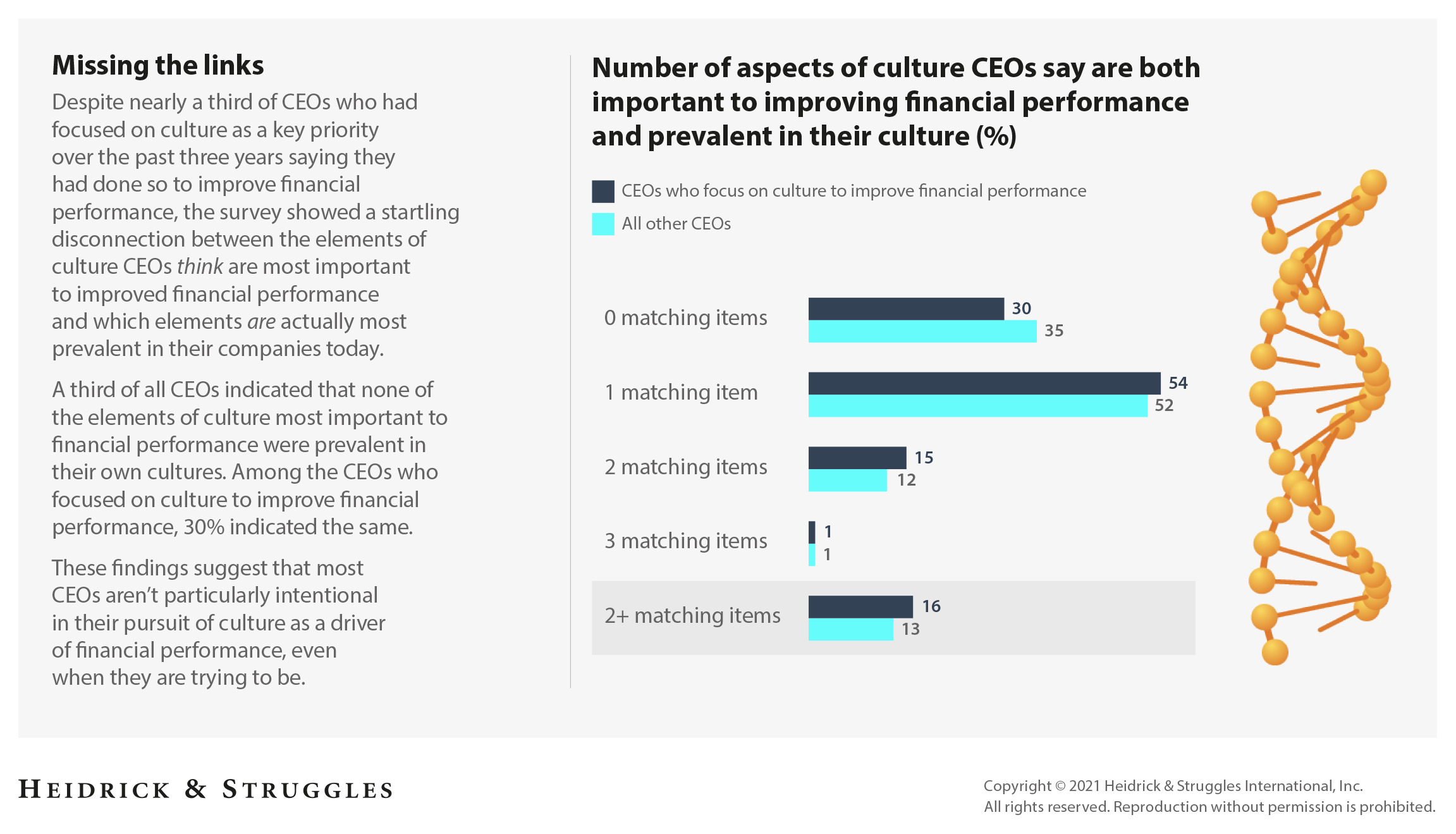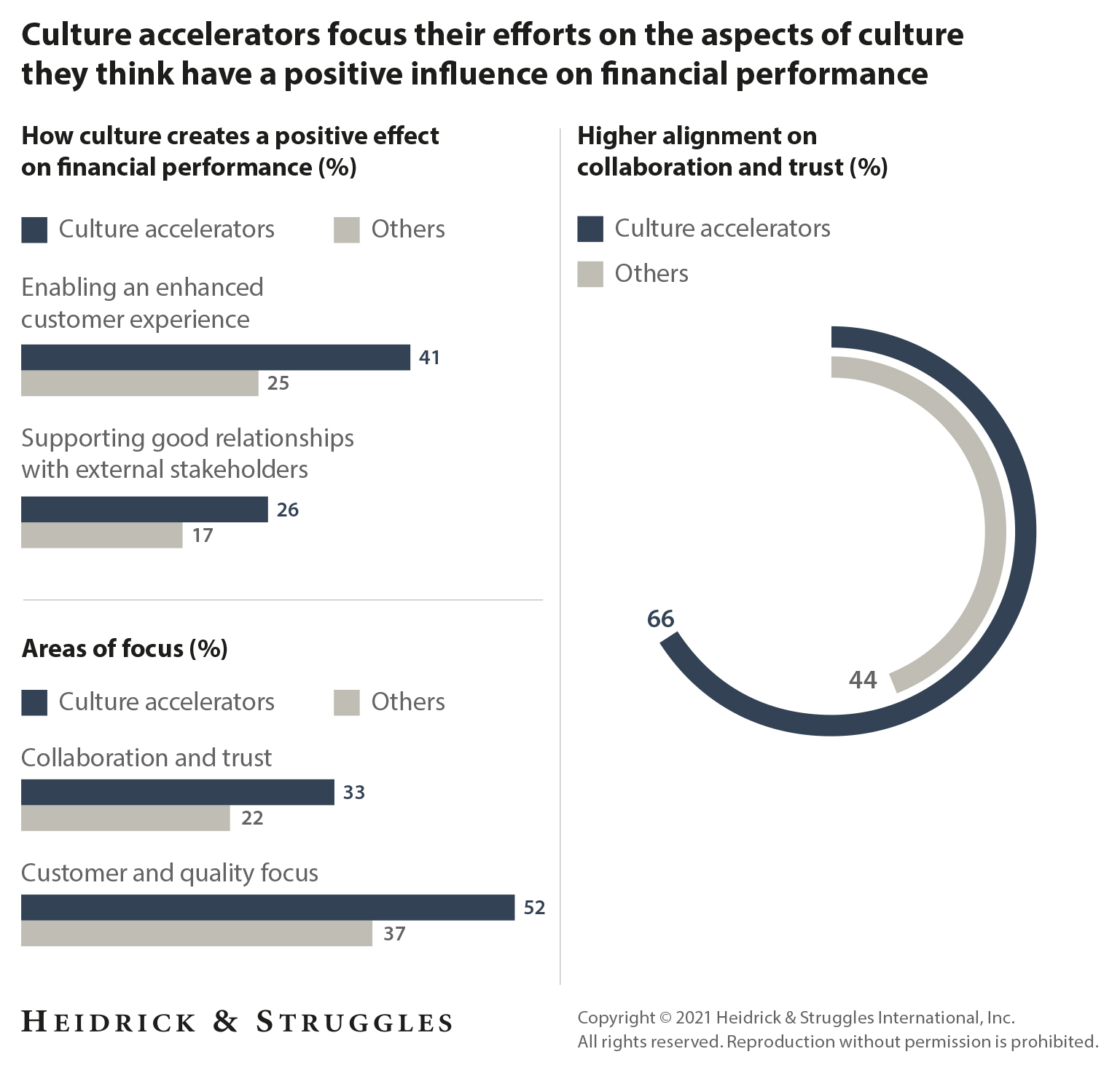Culture Shaping
Aligning Culture with the Bottom Line: How Companies Can Accelerate Progress
Earlier this year, we surveyed 500 CEOs at large companies around the world about how they define culture and how it influences financial performance. We also asked them why and how they work to cultivate their own organizational cultures. During the pandemic and amid all the other varied challenges 2020 brought to countries, communities, and companies around the world, organizational culture was challenged—and became, for many organizations, the essential glue that held them together. Now, as leaders work to maintain resilience in hybrid and fast-changing working conditions, the increased sense of purpose, inclusion, and collaboration that culture nurtures matters more than ever to enable individuals and organizations to thrive.
Our findings suggest that most CEOs make culture a priority, as we believe they should. But, surprisingly, we also see that most aren’t particularly intentional in their pursuit of culture as a driver of financial performance, even when they try to be. The connection between financial performance and a thriving culture was complex to make even before the pandemic. Now, with the growing focus on culture as employees return to the office and navigate hybrid work environments, it is more important than ever that companies’ culture efforts create the greatest benefit and highest impact possible. Our survey shows that 82% of CEOs said they had made culture a key priority over the past three years, often to improve financial performance. But, when asked about the most important drivers of financial performance, 74% picked something else, most often strategy and leadership.
What’s more, we found a startling disconnection between the elements of culture CEOs think are most important to improving financial performance and what elements actually are most prevalent in their companies today.
One group of survey respondents is more successful in their culture efforts than others.1 We call them the “culture accelerators” because they say that culture is a top-three driver of their financial performance, that it’s very important or crucial to link culture to strategy in order to ensure a positive effect on financial performance, and that they have focused on culture shaping as a key priority over the past three years.
The companies led by culture accelerator CEOs have financial performance (assessed by a three-year revenue CAGR) that’s more than double that of other companies we surveyed: 9.1% for this group, compared with 4.4% for the others.2 Coupled with other notable differences described in this report, the data suggest that these CEOs are far more intentional about culture than other leaders. They are purposeful in acting on their belief that culture makes a difference to financial performance and start with a direct link between culture and strategy. They then focus on building broad engagement by putting people first to ensure that culture has a positive effect on performance. Purposeful leadership and broad engagement are two of the four pillars our work has long shown to be central to shaping cultures. Because thriving cultures will be the linchpin of success going forward, other leaders can benefit from seeing how these leaders have accelerated their approach to culture.
This report is the first step in our work to cultivate an in-depth understanding of how culture drives stronger organizational performance; next, we will be interviewing CEOs around the world to understand their different approaches to this crucial aspect of organizational performance, especially as many organizations begin the return-to-office process and confront the challenges of a hybrid work environment.
How most companies are approaching culture—and missing some crucial links
Organizational culture has become an increasingly high priority for executives in recent years. Even before the COVID-19 pandemic, many executives working to lead in a quickly changing business environment with an evolving talent pool were seeing that a thriving culture could provide a competitive edge in innovation, employee attraction and retention, and agility, among other areas. Eighty-two percent of CEOs we surveyed said they had focused on culture as a key priority over the past three years. They did so for a variety of reasons, with improving financial performance being the most frequent response, followed by increasing employee engagement.
When asked if they had reached their cultural goals, there was marked variation. More than half of respondents met goals such as increasing employee engagement, improving diversity and inclusion, and improving financial performance. But other goals, including reinforcing a change in strategy and addressing ethics or compliance issues, were harder to meet. (For more, see chart, “Extent to which company reached its culture goals, by goal,” on page 6 of the full report.)
Regardless of success in reaching a specific goal, most CEOs, 74%, said their employees are mostly or entirely engaged in applying their cultural values in their day-to-day work. Notably, that percentage doesn’t vary much regardless of whether the workforce is working mostly in person (77%) or in a more fluid, hybrid working model (73%).
What culture accelerators do differently
While our survey showed that many CEOs aren’t as attuned to culture shaping in direct support of financial performance as they could be, a small group of companies has explored culture with strategic intent and puts people first. Whether their goal was to improve financial performance or something else, these companies have stronger financial performance (assessed by a three-year revenue CAGR) than other companies we surveyed: 9.1% compared with 4.4%.
Eleven percent of the CEOs surveyed led companies in this group. To be included, they had to say that culture was a top-three driver of their financial performance, that it was very important or crucial to link culture to strategy in order to ensure a positive effect on financial performance, and that they had intentionally worked on building and shaping their organizational culture over the past three years. It is notable that the mix of cultural accelerators in terms of region, industry, and size is slightly different than the overall sample, but not statistically significantly different. Thus, this more successful approach to culture shaping is agnostic in terms of geography, sector, and size.
Starting with culture
In our experience, companies often know they need to align strategy, operating models, and culture, but they don’t know where to start. This isn’t the case with culture accelerator CEOs; only 19% said that focusing on operating models was among the top-three positive influences on financial performance, compared to 40% of other CEOs. In addition, 48% of culture accelerators said they focused on culture to reinforce a change in strategy or direction, compared to only 22% of others. Combined with the culture accelerator–led companies’ stronger financial performance, these findings suggest that starting with culture may be the right first step.
Focusing on what makes a difference: people
Culture accelerators more often than others say the aspects of culture that affect financial performance are people related, such as enhancing customer experience and supporting good relationships with external stakeholders. And they more often zero in on two elements of culture to create that positive effect: customer and quality focus and collaboration and trust. It’s also notable that, more often than other CEOs, culture accelerators go beyond just saying collaboration and trust are important; they say those qualities are prevalent in their own cultures and then reinforce those qualities by communicating them, both internally and externally.
In addition, our survey showed that 48% of culture accelerator CEOs put diversity, equity, and inclusion (DE&I) efforts front and center, compared to 30% of other CEOs. This further indicates that, for the culture accelerators, putting people first is more than a platitude; it’s the crux of their approach to culture. And two-thirds of these CEOs also said they completely met or exceeded their culture goals, with 15% saying they exceeded those goals, compared to 5% of others.
The culture connectors
Within the group of culture accelerators, we dug a level deeper to identify a small group we call “culture connectors.” In addition to having strategic intentionality, these companies have broad engagement with their culture: all leaders said that their employees are mostly or entirely engaged in applying the company’s culture in their day-to-day work. In addition, these companies achieved or exceeded their culture goals. While only 30 CEOs in our survey fall into this group, our findings suggest that their organizations focus even more tightly on clear, effective communication, both internally and externally, and that they go the extra mile to engage all their people. This approach appears to be working to their financial benefit: the culture connectors had a higher three-year revenue CAGR than others we surveyed—8% compared with 4.8%. (While their revenue growth rate was slightly lower than the full group of accelerators, there is a higher share of the very largest companies— those with more than $10 billion in annual revenue—in the culture connectors group.)
Taking a look at how culture connectors have managed to broadly engage their workforce, it seems that including employees at all levels is the first step. Thirty-seven percent of these CEOs said bolstering culture can strengthen financial performance because it encourages people to go beyond what is normally expected. To do this, two best practices emerged. First, these CEOs said engaging people at all levels of the company is crucial to building culture. Nearly two-thirds of culture connector CEOs who said appreciation and recognition are an element of culture that supports financial performance also said that it’s prevalent in their culture—much higher than the share of other CEOs who said so and 26% higher than culture accelerators. What’s more, 30% of culture connector CEOs said that challenging employees to be accountable for living the culture is one of the most important ways they can personally ensure their company has a thriving culture, a far higher share than CEOs not in this group. (For more, see chart, “How do they broadly engage their people?” on page 10 of the full report.)
Second, culture connectors indicated that communicating at scale is also central to success. All culture connectors said holding two-way dialogues with employees about the importance of culture helped promote culture—20% more than culture accelerators and more than double other CEOs. Compared to others, culture connectors also hold more large-scale dialogue discussions to develop culture (40% versus 24%) and look for a variety of ways to understand how employees are feeling, including using sentiment analyses. Perhaps most important, culture connector leaders live the culture; when asked about how they communicate at scale, 80% of these CEOs selected “personal commitment to focusing on culture,” compared to 66% of culture accelerators and 45% of others.
Building a thriving culture today
As CEOs seek to help their companies thrive in the current hybrid, fast-changing environment, a thriving culture will be their best tool. The survey results reinforce the benefit companies can see when they link their culture to their strategy and create broad engagement with the culture. Our four principles of culture shaping suggest how they can get started.3
Purposeful leadership |
In the past year, we have seen data from other surveys and a great deal of anecdotal evidence showing that having a socially meaningful purpose has become a crucial characteristic of organizational leadership and culture across the globe. Key aspects of being purposeful as a leader are being inclusive, leading with influence instead of authority, and adapting leadership approaches to the way people work. Inclusive leaders also foster collaboration by involving many people in implementing new ideas, instead of operating in a silo and dictating change. CEOs who are culture accelerators act on their belief that culture is a key driver of financial performance by linking it to strategy. Leaders who live the culture, as most culture connector CEOs do, bolster this approach even more. (For more, see “What inclusive leaders do—and don’t do.”)
Personal change |
Leaders who can live the culture and challenge others to do so will help build a leadership team of culture accelerators and connectors. Leaders who don’t currently make the links between culture and financial performance will benefit from shifting their mindsets in that direction. Once they think of culture as a strategic asset and connect the missing links between culture and financial performance, they can be role models for and encourage other leaders to do the same. And, once employees see how leaders change their own mindsets, they’ll be more likely to follow suit—the start of broad engagement so that soon everyone is living the culture.
Broad engagement |
As discussed, many of the tactics used by culture connector CEOs, such as ensuring employees at all levels of the organization are appreciated and challenged, can help drive broad engagement. The more energetic and communicative leaders are about the culture-shaping process, the more likely momentum will spread throughout teams. All leaders heading down this path will benefit from making more use of these tactics.
Systemic alignment |
Along with recognizing that culture shaping must be reinforced across all parts of the organization, leaders must ensure that talent development and review processes, onboarding, and training include ways to develop and bolster the aspects of culture that are most important to driving financial performance. We have seen companies be most effective when they use balanced scorecards that include financial performance and culture performance metrics to regularly assess progress. One example includes market share, stock price, and net promoter score alongside employee engagement, employee retention, and the rate of internal promotions.
Take the first step
Amid all the other goals companies have in today’s uncertain world, internal efforts such as culture can sometimes be treated like afterthoughts. But our survey shows that companies that link culture to strategy and focus on people first also see better financial performance. Through the course of the year, we will be interviewing CEOs around the world to understand in more depth their different approaches to this crucial aspect of organizational performance.
About the authors
Rose Gailey (rgailey@heidrick.com) is the leader of Organization Acceleration, Culture Shaping, and Diversity & Inclusion for Heidrick Consulting; she is based in Heidrick & Struggles’ Costa Mesa office.
Ian Johnston (ijohnston@heidrick.com) is a partner in the London office and a member of Heidrick Consulting.
Andrew LeSueur (alesueur@heidrick.com) is a partner in the Stamford office and global managing partner of Heidrick Consulting. He is also a member of the Industrial Practice.
Acknowledgments
The authors wish to thank Krishnan Rajagopalan, CEO, and Ed Manfre, partner, for their contributions to this report.
References
1 There are 54 CEOs in this group, 11% of the total survey sample.
2 Heidrick & Struggles’ analysis of financial data on the publicly held companies responding to the survey, which was collected and anonymized by a third party and provided to Heidrick & Struggles. For more on the methodology and demographics of this report, see section “Methodology” and chart “Overall respondent demographics” on page 4 of the full report.
3 For more on shaping cultures that drive performance, see our forthcoming book, Future Focused: Shape Your Culture, Shape Your Future.



